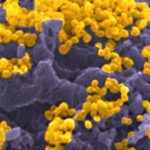Link to Pubmed [PMID] – 16892487
Proteomics 2006 Sep;6(17):4829-37
In most autoimmune diseases, the autoantibody response is directed against several antigens of the target organ whose identification is crucial for understanding the physiopathological process. Thus, technologies allowing a characterization of the whole autoantibody pattern of both human and experimental autoimmune diseases are required. Here we have used immunoproteomic analysis of human epidermal extracts to characterize the diversity of the anti-desmosome antibody response induced in normal mice immunized with desmoglein 1, the major autoantigen of pemphigus foliaceus, an autoimmune blistering skin disease. In particular, this analysis enables us to characterize the binding properties of anti-desmosome mAbs derived from these mice and to show that the autoantibody response induced upon immunization with a single autoantigen targets different epidermal autoantigens with a pattern similar to that observed in certain variety of human pemphigus.

